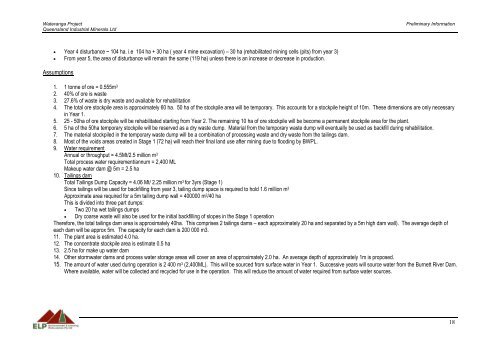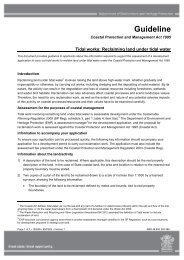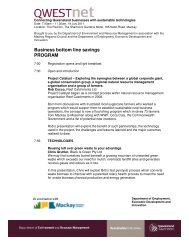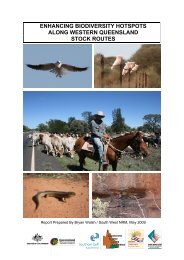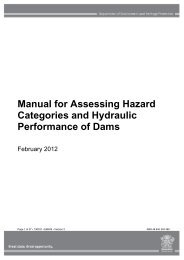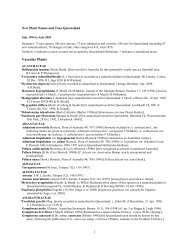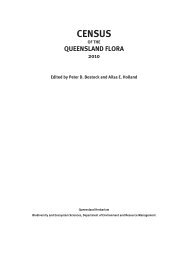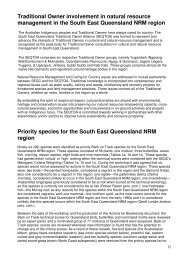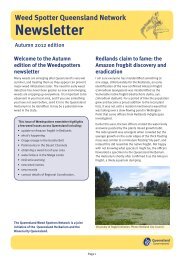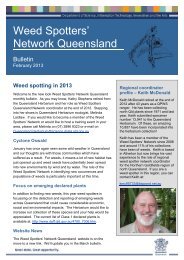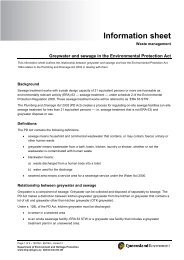WATERANGA PROJECT - Department of Environment and Heritage ...
WATERANGA PROJECT - Department of Environment and Heritage ...
WATERANGA PROJECT - Department of Environment and Heritage ...
You also want an ePaper? Increase the reach of your titles
YUMPU automatically turns print PDFs into web optimized ePapers that Google loves.
Wateranga Project Preliminary Information<br />
Queensl<strong>and</strong> Industrial Minerals Ltd<br />
• Year 4 disturbance ~ 104 ha. i.e 104 ha + 30 ha ( year 4 mine excavation) – 30 ha (rehabilitated mining cells (pits) from year 3)<br />
• From year 5, the area <strong>of</strong> disturbance will remain the same (119 ha) unless there is an increase or decrease in production.<br />
Assumptions<br />
1. 1 tonne <strong>of</strong> ore = 0.555m 3<br />
2. 40% <strong>of</strong> ore is waste<br />
3. 27.6% <strong>of</strong> waste is dry waste <strong>and</strong> available for rehabilitation<br />
4. The total ore stockpile area is approximately 60 ha. 50 ha <strong>of</strong> the stockpile area will be temporary. This accounts for a stockpile height <strong>of</strong> 10m. These dimensions are only necessary<br />
in Year 1.<br />
5. 25 - 50ha <strong>of</strong> ore stockpile will be rehabilitated starting from Year 2. The remaining 10 ha <strong>of</strong> ore stockpile will be become a permanent stockpile area for the plant.<br />
6. 5 ha <strong>of</strong> the 50ha temporary stockpile will be reserved as a dry waste dump. Material from the temporary waste dump will eventually be used as backfill during rehabilitation.<br />
7. The material stockpiled in the temporary waste dump will be a combination <strong>of</strong> processing waste <strong>and</strong> dry waste from the tailings dam.<br />
8. Most <strong>of</strong> the voids areas created in Stage 1 (72 ha) will reach their final l<strong>and</strong> use after mining due to flooding by BWPL.<br />
9. Water requirement<br />
Annual or throughput = 4.5Mt/2.5 million m 3<br />
Total process water requirement/annum = 2,400 ML<br />
Makeup water dam @ 5m = 2.5 ha<br />
10. Tailings dam<br />
Total Tailings Dump Capacity = 4.06 Mt/ 2.25 million m 3 for 3yrs (Stage 1)<br />
Since tailings will be used for backfilling from year 3, tailing dump space is required to hold 1.6 million m 3<br />
Approximate area required for a 5m tailing dump wall = 400000 m 2 /40 ha<br />
This is divided into three part dumps:<br />
• Two 20 ha wet tailings dumps<br />
• Dry coarse waste will also be used for the initial backfilling <strong>of</strong> slopes in the Stage 1 operation<br />
Therefore, the total tailings dam area is approximately 40ha. This comprises 2 tailings dams – each approximately 20 ha <strong>and</strong> separated by a 5m high dam wall). The average depth <strong>of</strong><br />
each dam will be approx 5m. The capacity for each dam is 200 000 m3.<br />
11. The plant area is estimated 4.0 ha.<br />
12. The concentrate stockpile area is estimate 0.5 ha<br />
13. 2.5 ha for make up water dam<br />
14. Other stormwater dams <strong>and</strong> process water storage areas will cover an area <strong>of</strong> approximately 2.0 ha. An average depth <strong>of</strong> approximately 1m is proposed.<br />
15. The amount <strong>of</strong> water used during operation is 2 400 m 3 (2,400ML). This will be sourced from surface water in Year 1. Successive years will source water from the Burnett River Dam.<br />
Where available, water will be collected <strong>and</strong> recycled for use in the operation. This will reduce the amount <strong>of</strong> water required from surface water sources.<br />
18


